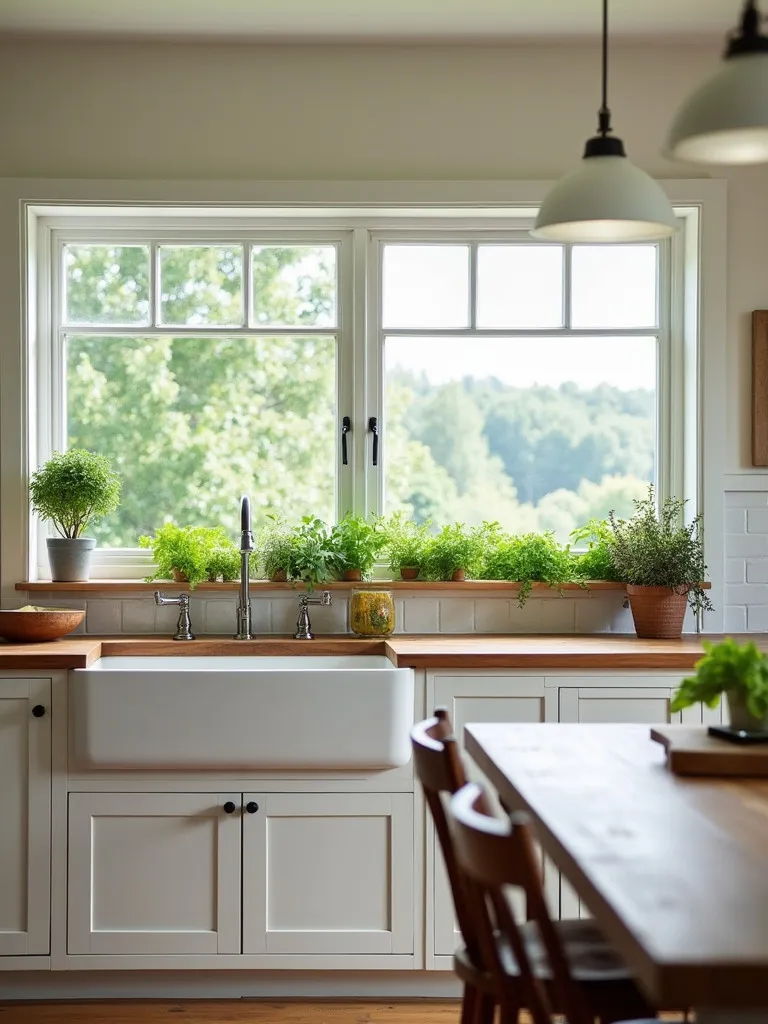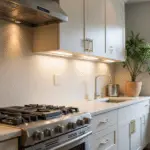Picture this: a sun-drenched kitchen, the heart of your home, where the centerpiece isn’t just functional—it’s a statement piece that ties the whole room together. That’s the magic of a farmhouse kitchen sink. As I stand in my kitchen, running my fingers along the smooth edge of my fireclay sink, I’m reminded of why these beauties have captured the hearts of so many homeowners.
Did you know that over 70% of us consider a farmhouse kitchen sink essential for our dream kitchens? It’s not just about aesthetics—though let’s be honest, they’re gorgeous. These sinks are workhorses, offering ample space for washing oversized pots and prepping meals. They’re the perfect blend of form and function, making them a must-have for modern homes with a touch of rustic charm.

Whether you’re designing your farmhouse kitchen remodel or simply dreaming of upgrading your sink, understanding the ins and outs of farmhouse sinks will help you make an informed decision. From materials that’ll stand the test of time to styles that’ll make your heart skip a beat, we’re diving deep into the world of farmhouse kitchen sinks. Let’s explore why this iconic fixture could be the perfect fit for your home, and how to choose one that’ll have you falling in love with your kitchen all over again.
Understanding Farmhouse Sinks: A Symphony of Style and Substance
When it comes to farmhouse kitchen sinks, we’re talking about more than just a place to wash dishes. These beauties are like the lead singer in your kitchen’s band—they command attention and set the tone for the entire space.
Types and Styles Overview
Let’s break it down, shall we? Farmhouse sinks come in a variety of styles, each with its unique flair. The star of the show is often the apron-front sink. Picture a sink with a bold, exposed front that just begs to be touched. It’s like wearing your favorite statement necklace—it catches the eye and elevates everything around it.

But don’t sleep on undermount designs. These sleek numbers blend seamlessly with your countertop, creating a clean, uninterrupted line that’s as smooth as a well-mixed cocktail. They’re perfect for those who want the farmhouse look without the drama.
Now, let’s talk materials. We’ve got options, folks:
- Stainless steel: The workhorse of the bunch. It’s like that reliable friend who’s always there when you need them.
- Fireclay: The classic beauty. It’s got that timeless charm that never goes out of style.
- Cast iron: The heavyweight champion. It’s sturdy and retains heat like a champ.
- Porcelain: The elegant one. It adds a touch of sophistication to any kitchen.
Each material has its personality, just like the eclectic mix of textiles in my living room. And speaking of personality, let’s not forget about bowl configurations. Single-bowl sinks are perfect for those big pasta pots, while double-bowl options let you multitask like a pro.
Pros and Cons: Weighing Your Options
Now, I know what you’re thinking—“Zara, these sinks sound amazing, but what’s the catch?” Well, my friend, like any good relationship, farmhouse sinks come with their ups and downs.

On the plus side, these sinks are deep enough to hide a week’s worth of dishes (not that I’m speaking from experience or anything). Their rustic charm can transform a kitchen faster than you can say “barn door.” And let’s be real, they’re just plain fun to use.
But, full disclosure: some materials might chip over time if you’re not careful. And installation? It can be a bit more involved than your standard sink. But hey, good things come to those who put in the effort, right?
Ideal Kitchen Styles: Finding Your Perfect Match
Here’s where it gets exciting. Farmhouse sinks are like the chameleons of the kitchen world—they can adapt to so many styles. They’re a natural fit for rustic and country kitchens, of course. But don’t be fooled—they can rock a modern farmhouse look like nobody’s business.
When it comes to color palettes, think warm and inviting. Creamy whites, soft grays, and natural wood tones are your best friends here. And don’t be afraid to mix materials! Pairing your sink with natural elements like wood and stone can create a look that’s as harmonious as a perfectly tuned guitar.

Remember, your farmhouse sink isn’t just a fixture—it’s a statement. It tells the story of your home, your style, and your love for beautiful, functional spaces. So choose wisely, and get ready to fall head over heels for your kitchen all over again.
Popular Sink Materials: Choosing Your Kitchen’s Superstar
Alright, my design-loving friends, let’s dive into the juicy details of farmhouse kitchen sink materials. Choosing the right material is like picking the perfect outfit for a big event—it sets the tone and needs to perform under pressure. Let’s break down the superstars of the sinking world and help you find your perfect match.
Stainless Steel: The Versatile Virtuoso
First up, we’ve got stainless steel—the chameleon of sink materials. I like to think of stainless steel as the little black dress of the kitchen world. It’s sleek, it’s chic, and it goes with just about everything.
Here’s why stainless steel might be your sink soulmate:
- It’s tough as nails. Scratches? Stains? Rust? Psh, stainless steel laughs in the face of such challenges.
- Cleaning is a breeze. A quick wipe and it’s back to its sparkly self.
- It’s like the middle child of sink materials—it plays well with both modern and traditional kitchens.
- Your wallet will thank you. Stainless steel is often more budget-friendly than its fancy cousins.

But here’s a little secret: opt for a lower gauge (thicker steel) for a sink that can take a beating and keep on ticking. And if you’re worried about noise, look for models with sound-dampening pads. Trust me, your ears will thank you during those late-night dishwashing sessions.
Cast Iron: The Timeless Heavyweight
Now, let’s talk about cast iron—the heavyweight champion of the sinking world. These beauties are like the vintage leather jackets of kitchens—they get better with age and never go out of style.
Cast iron sinks come with some serious perks:
- They’re coated with enamel, giving you a rainbow of color options. Want a sink that matches your favorite Le Creuset? You got it!
- Heat retention is their superpower. Perfect for soaking those stubborn pots and pans.
- Durability? Check. These sinks are in it for the long haul.
But fair warning: cast iron sinks are heavy. Like, heavy. Make sure your cabinets are ready for some serious weight-lifting before you commit. And while that enamel coating is tough, it can chip if you’re not careful. So maybe save the sword-fighting for outside the kitchen, okay?

Fireclay vs Porcelain: The Classic Contenders
Last but not least, let’s pit fireclay against porcelain in the battle of classic sink materials. Both bring a touch of elegance to your kitchen, but they’ve got some key differences.
Fireclay is like that friend who’s always put together, no matter what life throws their way:
- Its non-porous surface is a fortress against stains and odors.
- It can handle the heat, making it perfect for those of us who like to multitask in the kitchen.
- Chips and scratches? Fireclay says, “Bring it on!”
Porcelain, on the other hand, is the smooth operator of the sinking world:
- It’s got a glossy finish that screams “luxury.”
- Color options galore—it’s like having a rainbow in your kitchen.
- It’s lighter than Fireclay, making installation a bit easier.
But here’s the catch: porcelain can be a bit more high-maintenance. It’s more prone to scratches and chips, so you’ll need to treat it with a little extra TLC.

When it comes down to it, choosing between fireclay and porcelain is like choosing between chocolate and vanilla—it’s all about personal preference and how it fits into your kitchen’s overall vibe.
Remember, your farmhouse kitchen sink is more than just a place to wash dishes—it’s the heart of your kitchen. So choose a material that not only looks amazing but also fits your lifestyle. Whether you’re a messy cook (guilty as charged!) or a neat freak, there’s a perfect farmhouse sink material out there for you. Happy sink shopping, my friends!
Installation Process: Bringing Your Dream Sink to Life
Alright, my DIY warriors and home improvement enthusiasts, let’s talk about turning that farmhouse kitchen sink dream into a reality. Installing a farmhouse sink is like orchestrating a small kitchen revolution—it takes planning, precision, and maybe a little bit of elbow grease. But trust me, the result is so worth it!
Preparation and Planning: Laying the Groundwork
Before you even think about wielding that wrench, let’s get our ducks in a row. Proper preparation is like setting the stage for a great performance—it makes everything that follows so much smoother.

First things first: measurements are your new best friend. Grab that tape measure and get intimate with your cabinet space. Remember, farmhouse sinks are like the divas of the sinking world—they need their space. Make sure you’ve got enough room not just for the sink, but for any plumbing adjustments you might need to make.
Speaking of plumbing, here’s a hot tip: take a good, hard look at your current setup. Older plumbing might need some TLC to play nice with your new sink. It’s like introducing a new pet to your household—sometimes things need a little adjustment period.
Now, let’s talk support. Farmhouse sinks are typically heavier than your average sink. They’re like the sumo wrestlers of the kitchen world. Your cabinets need to be ready to handle that weight. Consider reinforcing the cabinet base—think of it as giving your sink a nice, sturdy throne to sit on.
Step-by-Step Guide: Making It Happen
Alright, let’s roll up our sleeves and get down to business. Here’s a step-by-step guide to installing your farmhouse kitchen sink:
- Out with the old: Carefully remove your old sink. It’s like saying goodbye to an old friend, but trust me, you’re about to make a fabulous new one.
- Clean sweep: Give that area a good cleaning. Think of it as creating a blank canvas for your new masterpiece.
- Support system: Install that reinforcement we talked about earlier. Your sink needs a strong foundation, just like any good relationship.
- Sink placement: Carefully lower your new farmhouse sink into place. This is the moment of truth, folks!
- Seal the deal: Use silicone to seal around the edges. This is crucial for preventing water damage. Think of it as giving your sink a waterproof hug.
- Hook it up: Connect all your plumbing fixtures. Double-check for leaks—nobody likes a crybaby sink.

Remember, sealing those edges is super important. A good seal is like a good secret—it keeps things from leaking out when they shouldn’t.
DIY vs Professional Help: Knowing When to Call in the Cavalry
Now, I know some of you are itching to tackle this project yourselves. And hey, I’m all for a good DIY challenge. Installing a farmhouse sink can be a DIY project if you’ve got the skills and the tools.
But let’s be real for a second. If you’re not 100% confident in your plumbing skills, or if you’re dealing with tricky cabinet modifications, it might be time to call in the pros. Think of it this way: a professional installation is like insurance for your beautiful new sink. It might cost a bit more upfront, but it can save you from potential headaches (and water damage) down the line.
If you do decide to go the DIY route, make sure you’ve got all the right tools and a good set of instructions. And maybe have a plumber’s number on speed dial, just in case. There’s no shame in asking for help if you get in over your head.
Remember, at the end of the day, the goal is to have a beautiful, functional farmhouse sink that you’ll love for years to come. Whether you install it yourself or bring in the pros, what matters most is that it’s done right.

So there you have it, folks—your roadmap to farmhouse sink installation success. Whether you’re a DIY daredevil or prefer to leave it to the experts, you’re now armed with the knowledge to make it happen. Now go forth and create the farmhouse kitchen of your dreams!
Important Considerations: The Devil’s in the Details
Alright, my design-savvy friends, we’re in the home stretch of our farmhouse kitchen sink journey. But before you rush off to pick out your dream sink, let’s talk about some crucial details that can make or break your farmhouse sink experience. These are the little things that might not seem important at first, but trust me, they can have a big impact on your daily kitchen life.
Size and Space Requirements: Finding the Perfect Fit
When it comes to farmhouse sinks, size does matter. It’s like choosing the right pair of jeans—you want something that fits just right and makes everything look good.
Most farmhouse sinks fall between 30 and 36 inches in width. But here’s the thing: you need to think beyond just the sink itself. Consider the space around it too. You’ll want enough counter space on either side for food prep and cleaning. After all, a sink is great, but not if you have nowhere to put your chopping board!

Depth is another crucial factor. A deeper sink can be a game-changer for washing big pots or hiding dirty dishes (we’ve all been there, right?). But remember, if you’re on the shorter side like me, a super deep sink might have you feeling like you’re reaching into a well every time you do the dishes.
Here’s a hot tip: measure the width of your base cabinet. This will give you the maximum size your sink can be. And don’t forget to factor in any decorative panels or moldings that might eat into that space.
Suitable Faucet Options: The Perfect Partner for Your Sink
Choosing a faucet for your farmhouse sink is like finding the right dance partner—you want something that complements your sink’s style and keeps up with its functionality.
High-arc faucets are a popular choice for farmhouse sinks. They give you plenty of clearance to fill tall pots or vases. Plus, they just look elegant, don’t they? It’s like adding a beautiful piece of jewelry to your kitchen.
Pull-down or pull-out sprayers are also worth considering. They make rinsing dishes a breeze and can help keep your sink area tidy. It’s like having a secret weapon hidden in plain sight.

When it comes to finishes, think about what will complement your new farmhouse kitchen cabinets. Brushed nickel, oil-rubbed bronze, or even matte black can add a beautiful touch to your sink area. Just make sure the finish you choose plays well with your sink material and overall kitchen design.
Remember, your faucet isn’t just a tool—it’s a design element. Choose something that not only works well but also makes you smile every time you turn on the tap.
Special Cabinet Needs: Supporting Your Sink’s Dreams
Last but not least, let’s talk cabinets. Your farmhouse sink might be the star of the show, but your cabinets are the unsung heroes holding everything together.
Farmhouse sinks, especially those made of heavy materials like cast iron or fireclay, need some serious support. It’s like trying to hold a watermelon with one hand—you’re going to need some help.
Consider reinforcing your cabinet with additional framing. This might mean adding support bars or even a plywood deck. It’s like giving your sink its own personal weightlifting platform.
If you’re installing an apron-front sink, you might need to modify your existing cabinet. This could involve cutting away part of the cabinet front to accommodate the sink’s apron. It’s a bit like giving your cabinet a fancy new haircut.

Custom cabinetry can be a great option if you’re starting from scratch. It allows you to design the perfect support system for your sink from the get-go. Plus, it allows you to create a seamless look that perfectly matches your kitchen style.
Remember, proper support isn’t just about preventing cabinet damage—it’s about ensuring your sink stays level and secure for years to come. Trust me, a wobbly sink is nobody’s friend.
As we wrap up our farmhouse sink adventure, keep these considerations in mind. The perfect sink isn’t just about looks—it’s about finding that sweet spot where style meets functionality. And don’t forget to consider choosing the perfect lighting to go with your farmhouse kitchen. The right lighting can make your new sink shine!
With the right size, a complementary faucet, and proper cabinet support, your farmhouse sink will be more than just a pretty face—it’ll be the hardworking heart of your kitchen, ready to take on whatever culinary adventures you throw its way.
Final Remarks: Embracing Your Farmhouse Sink Dream
Well, my fellow home design enthusiasts, we’ve journeyed through the wonderful world of farmhouse kitchen sinks together. From the charm of apron-front designs to the practicality of undermount options, we’ve explored it all. We’ve weighed the pros and cons, compared materials, and even rolled up our sleeves to talk installation. Now, as we wrap up our farmhouse sink adventure, let’s take a moment to reflect on why these beauties have captured our hearts and kitchens.

Farmhouse sinks are more than just a trend—they’re a statement about how we view our homes and our time spent in them. They harken back to a time when the kitchen was truly the heart of the home, a place of warmth, gathering, and nourishment. But they’re not just about nostalgia. These sinks bring a perfect blend of form and function to our modern lives.
Think about it: a deep, spacious basin that can handle everything from your biggest stock pot to a sink full of garden-fresh vegetables. An eye-catching design that elevates your entire kitchen aesthetic. Durable materials that can stand up to the rigors of daily use while maintaining their beauty. It’s no wonder over 70% of us dream of having one in our kitchens!
But here’s the thing: choosing the perfect farmhouse sink isn’t just about picking the prettiest option (although that’s certainly part of the fun). It’s about finding the right fit for your lifestyle, your cooking habits, and your design preferences. It’s about considering the practical aspects—like cabinet support and faucet compatibility—alongside the aesthetic ones.






